Little Yellow-Orange Underwings: Wingspans: 35-50mm

| **8878 Catocala amica WO;
Girlfriend; wingspan: 35-40mm
The black postmedian band is absent from the dorsal (upper)
surface of the hindwing, but it is present on the ventral surface.
Moths come in to lights and to bait.
Catocala amica lineella is sometimes treated as a subspecies;
sometimes as a distinct species.
John Himmelman image.
|
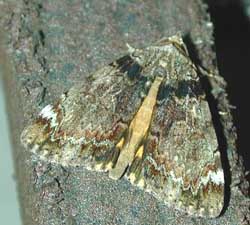
| ** 8874 Catocala minuta WO;
Little Underwing, 35-45mm.
Fw generally grey-brown with greatly widened
(near costa only), white, st line.
Hw outer black band unbroken, inner band
forms complete loop with considerable brown scaling along
im. Several forms:
"eureka": blackish area between am/pm lines;
"hiseri": dull grey fw with very faint markings;
"mellitula": blackish basal patch from costa to
im;
"obliterata": melanic form, almost completely
black fw;
"parvula": broad dark patch along fw im.
|

| ** 8876
Catocala micronympha; WO;
Little Nymph; wingspan 35-50mm
The usual specimens have grey forewings shaded with green, brown,
black and white tints. There is usually a darkened band passing from
the costa through the reniform spot to the outer margin.
There is high variability with this species.
John Himmelman image.
|
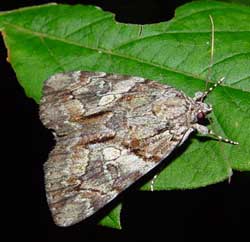
| Catocala mira WO/BG;
Wonderful Underwing, 40-50mm.
Fw pale basal area dstinguishes mira from
blandula (dark brown) and crataegi (black).
Fw lacks dark contrasting lines of crataegi and
blandula. Considerable brown in subterminal area; subreniform spot very conspicuous, usually brown.
Light area runs obliquely from costa to subreniform spot.
Noticeable space along im between
am and pm lines.
Hw: deep orange; complete inner black band.
Outer black band unbroken
Tim Dyson image. BG: LaSalle: July |
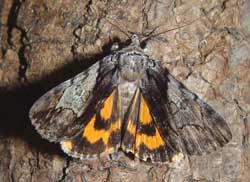
| ** 8858 Catocala crataegi WO;
Hawthorn Underwing, 40-50mm.
Determination based on dark (black) shading in fw basal
area continuing along ima to anal angle and brown shading
beyond postmedial line. Definite greenish cast to
median area.
The lower wing has the outer black band, broken near the anal angle,
distinguishing crataegi from blandula.
Tim Dyson image. |
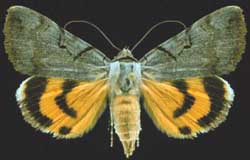
| ** 8841 Catocala abbreviatella BG;
Abbreviated Underwing; 40-50mm.
Fw uniformly colored with narrow black lines on
anterior half. Brown reniform spot ringed with black.
Hw outer black band abbreviated, then
continued with a dot. Inner black band terminates well
before im.
Similar species: Catocala nuptialis has solid black
reniform spot. C. whitneyi has broad dark triangles in middle of
forewing. BG: LaSalle: July-Aug.
|

| ** 8842 Catocala nuptialis WO;
Maried Underwing, wingspan 40-50mm.
The reniform spot is very dark, black or almost black on an otherwise
faintly marked, almost uniformly grey forewing.
The outer black margin of the hindwing is unbroken, but is indented
near the anal angle.
Jim Vargo image.
|
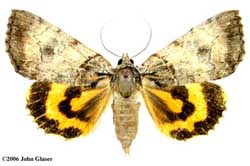
| ** 8871
Catocala dulciola WO;
Quiet or Sweet Underwing, wingspan: 40-45mm
A double black antemedial line (inner line broken only near the
costa) with other lines obscure distinguishes dulciola. There is also
a dark basal dash on an otherwise plain, light grey forewing.
John Glaser image.
|
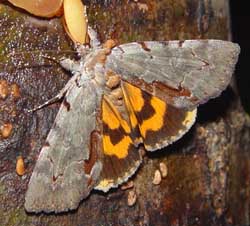
| ** 8864 Catocala grynea
WO/BG; Woody Underwing, wingspan: 40-50mm
The forewing is a dull greenish grey with orangey-brown shading along
the inner margin. The antemedial, median and postmedial lines are
quite faint.
Praeclara is somewhat similar but has a break in the brown shading
between the am and pm lines. Praeclara also has a paler orange
hindwing color.
Tim Dyson image. BG: LaSalle: July |
|
Midsized Orange-Salmon-Red-Scarlet Underwings: Wingspans: 50-72mm

| ** 8857 Catocala ultronia
BG;
Ultronia Underwing, wingspan: 50-63mm.
The forewings are typically gray-brown, with a distinct and very
dark inner margin and a characteristic light brown patch, underscored
by a very dark arc, near the wingtip.
There can be considerable variation from one specimen to the next.
Underwings can be yellow to orange to salmon.
|
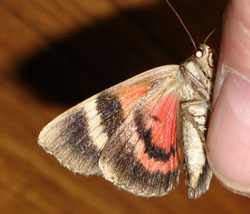
| Catocala ultronia,
the Ultronia Underwing, wingspan: 50-63mm.
There is extensive orange-salmon colouration on the ventral surface
of the hindwings and there is a dark discal lunule.
The ventral surface of the forewings also has a generous suffusion
of orange-salmon scales in the lower half of the median area.
Joe Garris photo. BG: LaSalle: July
|
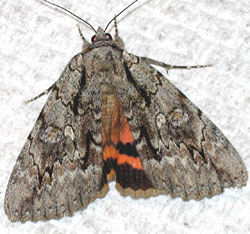
| #8778 Catocala habilis;
ILII; 55-65mm
Note large "M" on thorax and
"pork chop" shaped, light coloured subreniform spot that becomes very
dark in its constriction at juncture with pml. Pml
line narrow but dark, distinct, outwardly lined with
narrow suffusion of white scales, followed by broader band of brown, then another broader suffusion of white to
very regular dentation of subterminal line. Significant "bleeding" of yellow-orange to salmon scales into
hw fringes.
Large reniform spot has brown center, faintly edged with black, then
white, then black again. Joe Garris image. Bill Garthe: LaSalle: August
|

| #8795 Catocala palaeogama
; WO; 60-70mm
Subreniform spot closed, does not approach pm line,
smaller than in C. habilis.
All forms have characteristic orange, heavily barred fringe to
apex, irregular bands on hindwings. Hw basal median
area heavily suffused with dark brown to black scales.
Dark bar in outer half of median area,
paralleling im halfway between
inner margin and light, closed subreniform spot.
Joe Garris photo.
|

| #8795 Catocala palaeogama
form phalanga; WO; 60-70mm.
In this form, fw basal area and subterminal
area are very dark against much lighter background.
Dark bar in outer half of
median area, paralleling inner margin halfway between
inner margin and light, closed subreniform spot is especially
evident. Joe Garris image. BG: LaSalle: Aug.
|

|
Fw mottled with white, grey and brown, and
subrenifrom spot tends to be lighter in colour, although
sometimes obscured by indistinct blackish bar which runs from
middle of basal/thorax connection to just below much lighter
apex at the outer margin.
Jim Vargo image. BG: LaSalle: Aug. |

| ** 8851 Catocala coccinata, WO;
Scarlet; 57-70mm:
Usually diffuse basal and anal dashes on otherwise light
grey, mottled forewing.
Hindwing fringe white (often with some salmon scaling) and
heavily checked.
"Tooth" just below pair of very elongated "teeth" is
much reduced, quite rounded, usually allowing considerable room
for lighter patch of scales. Dark bar crosses thorax.
Reniform spot tends be to light, often with greenish cast.
|
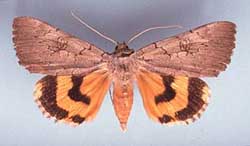
| ** 8840 Catocala illecta WO;
Magdalen Underwing, 60-70mm
Fw pattern and colouration much like that of concumbens,
pale grey with faint black lines.
Hws light yellow, irregular inner black band
terminates well before inner margin. James K. Adams image.
|

| Catocala briseis;
Briseis; wingspan 60-70mm; BG.
Fws predominantly mottled dark-grey-brown with some
lighter areas 1) between pm and subterminal lines, 2)
at very base of am and pm lines along
inner margin, and 3) over subreniform spot running diagonally
toward costa.
Pm lines have relativley short, blunt teeth.
Hw fringe white and unbroken and inner black band
(fairly even) reaches im.
Tim Dyson image.
|
|
Solid Black Underwings: Smallest to Largest, Similar Species Paired

| ** 8781 judith; BG;
Judith's; 45-55mm.
Smaller "black" underwings. Fw: uniform
light grey with thin and only slightly darkened antemedial, median
and pm lines. No darkened dashes (slight anal dash)
or transverse lines. Reniform area is slightly darkened while
area just before subterminal line is a bit lighter. Note absence of
hw white fringe.
Joe Garris photo. BG: LaSalle: Sept.
|
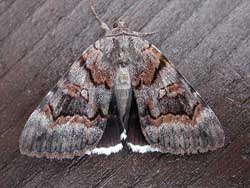
| ** 8773 Catocala epione WO;
Epione Underwing, wingspan: 55-65mm
The pm line is squared and has a brown band and then a light band
just outside the line. The hindwing is black with pure white fringe
with no barring.
John Himmelman image.
|

| ** 8782 Catocala flebilis WO;
Mournful, 54-65mm. Diffuse black band running from basal area to
om just below the apex, interrupted by pale grey
subreniform spot.Reniform spot filled with brown;
additional brown outside the postmedial line. No anal dash
as there is in angusi. Hws have white fringe.
|
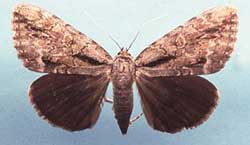
| ** 8783 Catocala angusi
WO; Angus' Underwing, 60-74mm; Dark dashes/streaks in basal area and anal area distinguish
this species. Reniform spot has light brown filling.
Hw fringe black except for white region at apex.
Form lucetta has broad black band from basal area to
om, broken by reniform and subreniform spots.
|
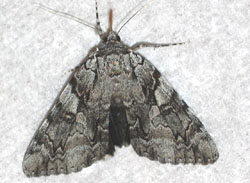
| Catocala dejecta WO;
Dejected; 56-73mm. Pale grey patch
from reniform and subreniform juncture to costal margin is
diagnostic. Note open, light "pork chop" shape of subreniform spot.
Two "teeth" in pm line above subreniform spot are relatively
short and blunt. Upper portion of am line thick, black;
lower half has light rounded lobes outlined in black.
Hw fringe white with black wing veins extending
like "teeth".
|

| Catocala retecta; BG;
60-75mm
Note light coloured, elongated and open subreniform spot
which interrupts dark, diffuse ark running through center of
wing from basal area (body-wing juncture) to fw
apex. Center of reniform spot brown, brown
area just below costa running to im just outside pm
line. Off-white hw fringe only lightly checked along
wing veins.
Joe Garris image. BG: LaSalle: Aug.-Sept.
|

| ** 8784
obscura; WO/BG;
Obscure; 60-72mm.
Dull, grey forewings, usually void of any significant dashes or
streaks, providing for easy identification. Am, median
and postmedial lines of obscura faint; subterminal line
region only slightly paler than rest of forewing.
The hindwing fringe is off-white and lightly checked on the veins.
Joe Garris photo. BG: LaSalle: July-Aug.-Sept.
|
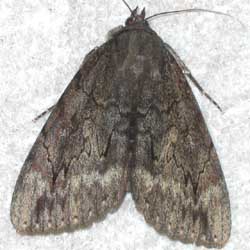
| Catocala residua; WO;
Residua; 60-73mm.
Distinguished from obscura by grey hw
fringe of residua. Obscura has white to off-white fringe;
less common in northern portions of its range. Fw
subterminal line/area of Catocala residua tends to be pale as
is its open, elongated subreniform spot.
Like C. obscura, otherwise devoid of significant markings
except for hint of dark bar running from basal area
through reniform spot to om just below apex.
Joe Garris image.
|
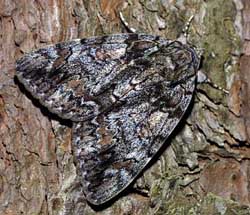
| ** 8794 Catocala lacrymosa WO;
Tearful Underwing, 60-82mm.
Fw highly variable with mixture of black, brown
(wing tips and outside pm line) and dark grey scaling.
Usually whitish crescents, along inner margin at
base of the antemedial and postmedial lines.
Hws black with white checkered fringe, turning black
near the anal angle.
|
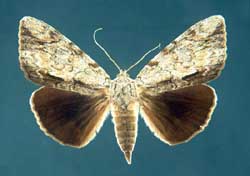
| ** 8791
Catocala insolabilis BG;
Inconsolable, 65-75mm
Fw light grey with blackish shading along im. Am and pm lines thin.
Hw fringe very narrow and grey, whiter toward
apex.
Ventral surface clearly distinguishes insolabis, being almost
completely black except for some white in basal area.
Vernon A. Brou image. BG: LaSalle: July
|
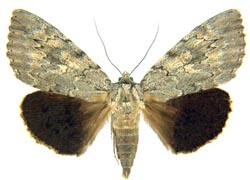
| ** 8780
Catocala robinsoni BG,
70-80mm;
Robinson's Underwing. Fw: plain pale.
Female has basal dash, absent in male.
Currata, is female form, having weak basal dash.
Rare form missouriensis, has dark, broad bar
extending from basal area to om just below
apex. Lighter grey rnfm and subrnfm spots break bar
in missouriensis.
White fringe on hws; bands on
ventral surface are prominent. BG: LaSalle: Sept.
|
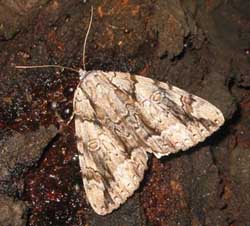
| ** 8792 Catocala vidua BG;
Widow; 70-80mm.
Fw light grey.
Distinct dark arc running through top of reniform spot
to just below apex. Heavy, dark anal and basal
dashes, connecting to dark median bar, running parallel to inner margin.
Am line thick, black in its upper half.
Reniform spot consists of two almost
concentric irregular ovals.
Subreniform spot light, open, but constricted as it
meets pml.
Hw black with broad, white fringe, only lightly
interrupted.
Marie Winn image. BG: LaSalle: Aug.-Sept. |

| ** 8793
Catocala maestosa WO/BG,
Sad Underwing, 78-98mm.
Maesotsa quite similar to, although usually larger than, vidua.
Both have dark arc from costa, above reniform spot, to
the outer margin just below apex. Maesotsa, however, lacks
dark bar, found on vidua, parallel to inner margin.
Reniform spot brown, brown shading just outside
postmedial line.
Hw fringe is white, narrow and heavily barred. BG: LaSalle: Aug.
|
|
Large Black Underwings (Banded): Wingspans: 70-80mm
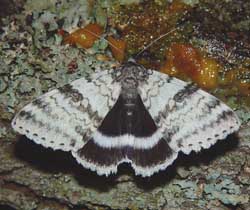
| ** 8803 Catocala relicta
BG;
Forsaken, White, Relict; 70-80mm.
Considerable variation with regard to black/white
concentrations on the forewings.
Form clara (depicted), has the basal and subterminal
areas predominantly white; the form phrynia, is
evenly dusted with grey over entire forewing.
Typical specimens have basal and subterminal areas filled with
blackish scales. Hws black with brilliant even white inner band and
white fringe,
are also distinctive. BG: LaSalle: Sept.
|

| ** 8802 Catocala cerogama BG;
Yellow-Banded; 70-80mm.
There are several different forms. Pm line is distinct, dark
and has elongate pair of projections. Pm and am lines meet inner
margin in relative proximity. Closed subreniform spot
it lighter than surrounding areas, shaped a bit like an
arrowhead with point toward body. Hws
distinctive. Jean-Benoît Duval image. BG: LaSalle: Aug-Sept. |
Large Orange-Salmon Underwings: Wingspans: 65mm, usually 70-95mm
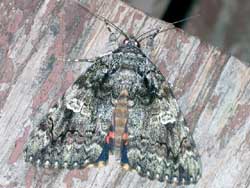
| ** 8801
Catocala ilia; BG; Ilia;
65-82mm.
Several different forms;
most have characteristic white area in and around
reniform spot. Diffuse dark arc running from this
spot to just below outer apex.
Except in worn specimens and darkest forms,
white dots near outer margin of forewing are in character
with overall "contrasting" appearance of this moth.
Joe Garris image. BG: LaSalle: July-Aug.
|
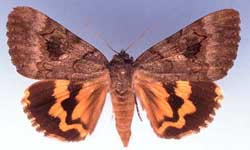
| ** 8772 Catocala consors WO;
Consort, 70mm plus.
Fw: irregular am and pm narrow black lines. Dark patch
outside the reniform and subreniform spots.
The orange-yellow hindwing pm band tends to be narrow and
irregularly zigzagged. Sometimes the band is wider and slightly less
irregular.
|

| ** 8771 Catocala piatrix
BG;
Penitent, 68-84mm.
The forewing has a light-colored band/bar extending from the
subreniform spot along the am line to the costa.
The fringe of the hindwing is lightly barred and is lighter in color
than the deeper orange on the rest of wing. BG: LaSalle: July-Aug.-Sept.
|
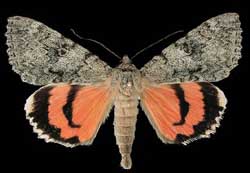
| Catocala junctura;
Joined Underwing; 67-85mm.
Fw usually dark brownish-gray to evenly powdered
blue-grey w/o significant markings. Doubled reniform spot
often obscure. Thin, slightly darker am, pm
lines run from costa to im, not widely
spaced at im.
Hw salmon or orange-pink with narrow inner black band
that turns in sharply but does not meet dark-haired im,
distinguishing it from unijuga.
BG: LaSalle: July-Aug.-Sept. |
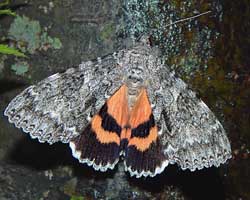
| ** 8805 unijuga; BG;
Once-married; 70-90mm.
Fairly wide black inner band (almost reaching inner margin) in
hindwing and very distinctive patterning in forewing. Meskei tend to
have narrower band and dustier (less distinct) looking forewing.
Semirelicta tend to have inner bands that terminate well before
im.
Also note very white fringe on both forewings and hindwings.
Carroll Rudy image. BG: LaSalle: Aug.
|

| ** 8806 Catocala parta BG;
Mother Underwing, 70-85mm.
Black dashes in basal, subapical and anal areas help to
identify this species. Hws may be yellow to
yellowish-orange but more often are salmon-red. Note the
face-head-like markings on the thorax.
In the hindwing, the first (nearest the apex) black protrusion into
the white fringe is "noticeably" larger than the others.
|
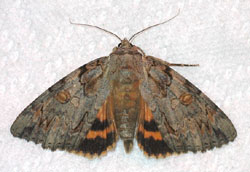
| ** 8798 Catocala neogama;
BG; 70-85mm.>
Note the brown head and thorax and larger size as compared to
C. palaeogama. Neogama specimens tend to be slightly smaller
than subnata, and have darker grey brown fws with more
pronounced markings. Examination of hind tibia is sometimes needed
for identification. Those of neogama tend to be flattened,
unevenly and sparsely spined while tibia of subnata are cylindrical
with spines dense and uniform in distribution.
Joe Garris photo. BG: LaSalle: July-Aug.-Sept.
|

| ** 8797 Catocala subnata
BG;
Youthful Underwing, 75-90mm.
Fws greyish white with blue-grey and light brown scales.
Hws usually brighter
yellow than those of neogama. Neogama usually
have basal dash; absent in male subnata, but present in females.
Magnification of hind tibia helps to distinguish two species:
subnata: cylindrical;
neogama: compressed or flattened.
subnata: ventral surface densely covered with evenly
distributed spines;
neogama: ventral surface sparsely covered with sporadic
spines. BG: LaSalle: July-Aug.-Sept.
|
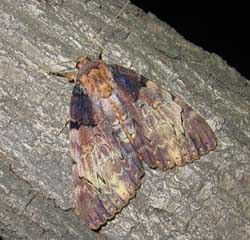
| ** 8796 Catocala nebulosa
BG;
Clouded; 75-86mm.
Prominent dark brown upper-half-basal patch extends
to, ends at am line. Apical area tends to be
brown, much darker than median area, not as dark as basal patch.
Anal angle also has darker brown scaling.
Pm line is distinct near costa and inner margin, but becomes
weak between the two. It meets inner margin in relative close
proximity to am line.
Closed subreniform spot is large and connects to the
pm line via a thin line. BG: LaSalle: Aug.-Sept.
|
|
Large Pink Underwings: Wingspans: 70-95mm

| ** 8834 Catocala amatrix
BG; Sweetheart; 75-95mm.
Fw usually has dark diffuse bar running from body to just below apex. Large, light, open subreniform spot interrupts bar.
Thorax grey, marked with dark brown prothoracic collar
followed almost immediately by dark bar. Abdomen light brown.
Hws pink to salmony-pink. White fringe
heavily checked with black. Black median band
relatively narrow, terminates well before im.
BG: LaSalle: July-Aug.-Sept.
|
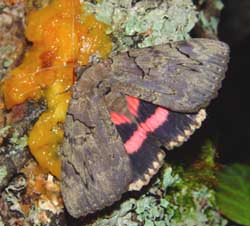
| ** 8832 Catocala cara BG;
Darling; 70-85mm.
Note deep maroon almost purple cast to fws, mixed with
very pale green. Lower half of am and pm lines barely
visible. No distinctive bars or dashes. Two upper
"teeth" on pm line thin, long.
Hw bands pink. Heavy black checking on
off-white hindwing fringe. Relatively thick black hw median band almost reaches inner margin which is usually heavily
adorned with dark hairs.
Tim Dyson image. BG: LaSalle: July-Aug.-Sept.
|
|
|